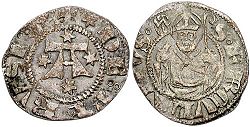
Bolognino
Encyclopedia

Bologna
Bologna is the capital city of Emilia-Romagna, in the Po Valley of Northern Italy. The city lies between the Po River and the Apennine Mountains, more specifically, between the Reno River and the Savena River. Bologna is a lively and cosmopolitan Italian college city, with spectacular history,...
and other cities of medieval Italy from the late 12th century to the 17th century.
The coin originated in 1191, when emperor Henry VI
Henry VI, Holy Roman Emperor
Henry VI was King of Germany from 1190 to 1197, Holy Roman Emperor from 1191 to 1197 and King of Sicily from 1194 to 1197.-Early years:Born in Nijmegen,...
granted Bologna the right to mint a silver denaro
French denier
The denier was a Frankish coin created by Charlemagne in the Early Middle Ages. It was introduced together with an accounting system in which twelve deniers equaled one sou and twenty sous equalled one livre...
. In 1236 this unit was rechristened Bolognino piccolo ("Small Bolognino") when the Bolognino grosso ("Big Bolognino") was introduced, with the value of a 12 soldi
Soldo
Soldo was the name an Italian medieval silver coin, issued for the first time in the late 12th century at Milan by Emperor Henry VI. The name derives from the late Roman coin solidus....
. It weighed 1.41&nbps;g of silver.
The grosso was adopted in other Italian communes and cities, such as Ravenna
Ravenna
Ravenna is the capital city of the Province of Ravenna in the Emilia-Romagna region of Italy and the second largest comune in Italy by land area, although, at , it is little more than half the size of the largest comune, Rome...
and Rimini
Rimini
Rimini is a medium-sized city of 142,579 inhabitants in the Emilia-Romagna region of Italy, and capital city of the Province of Rimini. It is located on the Adriatic Sea, on the coast between the rivers Marecchia and Ausa...
and copied by other mints, such as those of Lucca
Lucca
Lucca is a city and comune in Tuscany, central Italy, situated on the river Serchio in a fertile plainnear the Tyrrhenian Sea. It is the capital city of the Province of Lucca...
, Rome
Rome
Rome is the capital of Italy and the country's largest and most populated city and comune, with over 2.7 million residents in . The city is located in the central-western portion of the Italian Peninsula, on the Tiber River within the Lazio region of Italy.Rome's history spans two and a half...
and other cities in Abruzzo
Abruzzo
Abruzzo is a region in Italy, its western border lying less than due east of Rome. Abruzzo borders the region of Marche to the north, Lazio to the west and south-west, Molise to the south-east, and the Adriatic Sea to the east...
and Marche
Marche
The population density in the region is below the national average. In 2008, it was 161.5 inhabitants per km2, compared to the national figure of 198.8. It is highest in the province of Ancona , and lowest in the province of Macerata...
. The value changed depending from the current political and economic situation. In the late 15th century Kingdom of Naples
Kingdom of Naples
The Kingdom of Naples, comprising the southern part of the Italian peninsula, was the remainder of the old Kingdom of Sicily after secession of the island of Sicily as a result of the Sicilian Vespers rebellion of 1282. Known to contemporaries as the Kingdom of Sicily, it is dubbed Kingdom of...
, for instance, the value of a bolognino was 18 silver denari. The initial imperial dedication was later replaced by that to Bolognese ruling families, such as the Pepoli
Pepoli
The family of Pepoli were lords of Bologna who took power in the chaotic commune riven by the struggles between Guelfs and Ghibellines and ruled during the first half of the 14th century. Their seat in the city was Palazzo Pepoli Antico, constructed by Taddeo...
and the Visconti. In the 16th century, when the city fell under Papal control
Papal States
The Papal State, State of the Church, or Pontifical States were among the major historical states of Italy from roughly the 6th century until the Italian peninsula was unified in 1861 by the Kingdom of Piedmont-Sardinia .The Papal States comprised territories under...
, it showed the papal bust and the city's coat of arms.
The bolognino was no longer struck starting from the 18th century. Multiples up to 100 bolognini continued to exist, however.
A golden bolognino, introduced in 1380, had the value of 30 silver bolognini (same title and weight of the Papal ducato.

